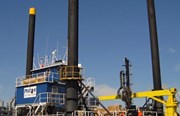How Sonic Keeps Infrastructure Projects on the Straight and Narrow
By: Cascade EnvironmentalIt’s almost cliché at this point— “sonic is the answer.” The technology is often touted as the do-all, be-all solution, despite the fact that for some projects, it may be overkill (or overspend). For infrastructure projects, however, sonic really is everything it’s hyped to be. Whether the project involves dams, shorelines, tunnels, or wells, it will require straight holes—and sonic is the only technology currently available that can provide borings with deviation less than 0.5% from vertical.
In this blog post, I’m discussing sonic drilling for infrastructure, but there are other applications where sonic should also be your first choice. I’ll be discussing some of them in my upcoming webinar, “How to Achieve High Quality Samples in Challenging Lithology” on July 10.
WHY IS VERTICALITY SO IMPORTANT?
Ideally, any drilled vertical hole would be exactly vertical, but we know that is not the case. Due to factors including the subsurface geology and the mechanics of the drilling methodology, many holes may deviate by as much as seven degrees off vertical in borings as shallow as 150 feet. In one instance, traditional mud rotary core drilling was used to install settlement casings in Portland, OR. The mud rotary borehole was so crooked the settlement casing was installed in the path of the tunnel, 7.5 feet off vertical from where it was started—and the instrument boring was only 115 feet in depth.
For many applications, some deviation is fine, but not when infrastructure is involved. A few examples of applications where verticality is crucial:
- Tie back placement – when providing reinforcement to a retaining wall, exact placement is demanded by engineering specs to ensure the weight load is evenly distributed and properly supported.
- Grout borings for dams – grout placement is important, and the borings must be precise in their placements, so grout borings do not connect.
- Tunnel confirmation – when a tunnel is constructed, it must start and end in the intended locations. Imagine driving through a tunnel and, at the end, discovering the road on the other side was actually several feet to the left!
- Angle boring for well placement under buildings – monitoring wells must be positioned at the exact angle required by the project plan in order to ensure it’s in the plume being monitored and/or remediated.
Clearly, the tight tolerances sonic provides make it a necessity in many infrastructure projects.
HOW DOES SONIC PROVIDE STRAIGHTER HOLES?
The main difference between sonic and other drilling methods is simply the override technique using sonic casing. Sonic boreholes are drilled by advancing a core barrel ahead in the formation and then overriding the core barrel. The casing is special, it is threaded and double mandrelled during production; the double mandrelling increases its strength and ensures tight straight tolerances. This guided borehole approach ensures the boring does not have a chance to wander.
A COUPLE REAL-LIFE EXAMPLES
A client in the Pacific Northwest required tunnel confirmation, and brought us in to drill down 105’ (the depth equaling the height of a 10-story building) to confirm the storm water overflow was in the exact spot it was intended. Using sonic, we did—then drilled three more in other locations, all with the same result.
Another client was faced with a dam at risk of internal erosion and potential failure, and needed us to install a series of plumb PVC guide casings as a construction guide for the drilling of a much larger secant pile. They also were interested in gaining more information about the subsurface in situ for subsequent construction work—sonic’s tight tolerances and ability to provide a continuous core made it the perfect solution.
YOU CAN READ ABOUT THE PROJECT HERE. >>
Hole deviation is not acceptable for many projects. When a straight hole is paramount, it’s time to bring in sonic.
If you are interested in learning more about sonic drilling, register now for my webinar, “How to Achieve High Quality Samples in Challenging Lithologies.”













